Blogs
Practical Insights & Latest Happenings
Don’t miss out on the latest trends and info on SEO, search engines, social media, and more.
December 1, 2023
mothasim

If you want to stay one step ahead of your competition in the ranking game, you need to look into their SEO tactics, find their best approaches, be cautious of their mistakes, and leverage all of that info to your benefit.
That means you need to first study your competitors carefully. But how to do competitor analysis in SEO?
This is what this blog is all about. Here we will make you familiar with the different types of competitor analysis and how to do each one of them with popular SEO tools.
Here are some ways to research on your competitors:
This one is self-explanatory. You research and discover keywords that your competitors are ranking for. The goal is to find new keywords that have high search volumes but low competition, which enhances their ranking possibilities.
It’s obvious that you’ll want to do better than your competitors in the SERPs. One of the best ways to do that is through developing killer content. The key is knowing how your competitors create, manage, and market their content. Analyze their strategies and implement the best ones.
You will need the backlink sources of your competition’s so you can reach out to those credible sources and gain quality and relevant inbound links.
The technical aspects of your competitor websites are also important. There are ways to check out their site speed, navigation and structure, indexing and crawl issues, and other technical aspects, and improve yours accordingly.
Yes, the social profiles of your competitors are worth looking into as well. You need to know how your competitors promote and market their brands on different social media platforms so you can see why they’re successful at their campaigns.
To start off with competitor analysis, first you need to figure out who you’re actually competing against. There are a few ways to list out your competitors:
You can directly search on Google or use SEO tools like Ahrefs, Moz or Ubersuggests, and look for your true competitors in the SERPs.
Imagine you are a tech firm located in Kansas City, Missouri. How do you find out your competitors?
Just Google something like “tech services in Kansas” and see what pops up.
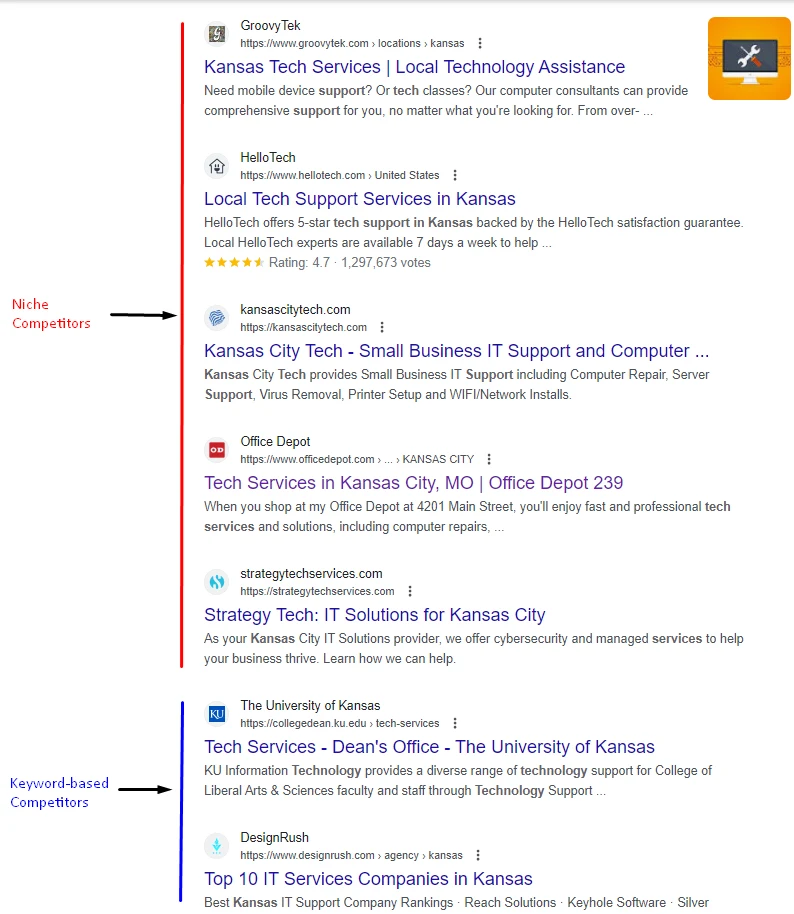
Your true competitors would be ones that provide similar services as yours. In this SERP, the first five websites, including GroovyTek, HelloTech and Strategy Tech are all tech firms in your area. So, they are your direct competitors and will rival you for the IT products and solutions you’re providing in Kansas.
Although the next few ones are also your competitors, they are not tech firms or services by any means but they’re still ranking alongside your niche websites.
The reason is that they’ve targeted similar keywords as yours. So, while they may not be competing for your products or services, they can still outrank you.
You’ll get similar results with SEO tools like SEMRush, Ahrefs or Moz.
Let’s take SEMRush for example. Go to the “Organic Research” feature and type in the same keyword.
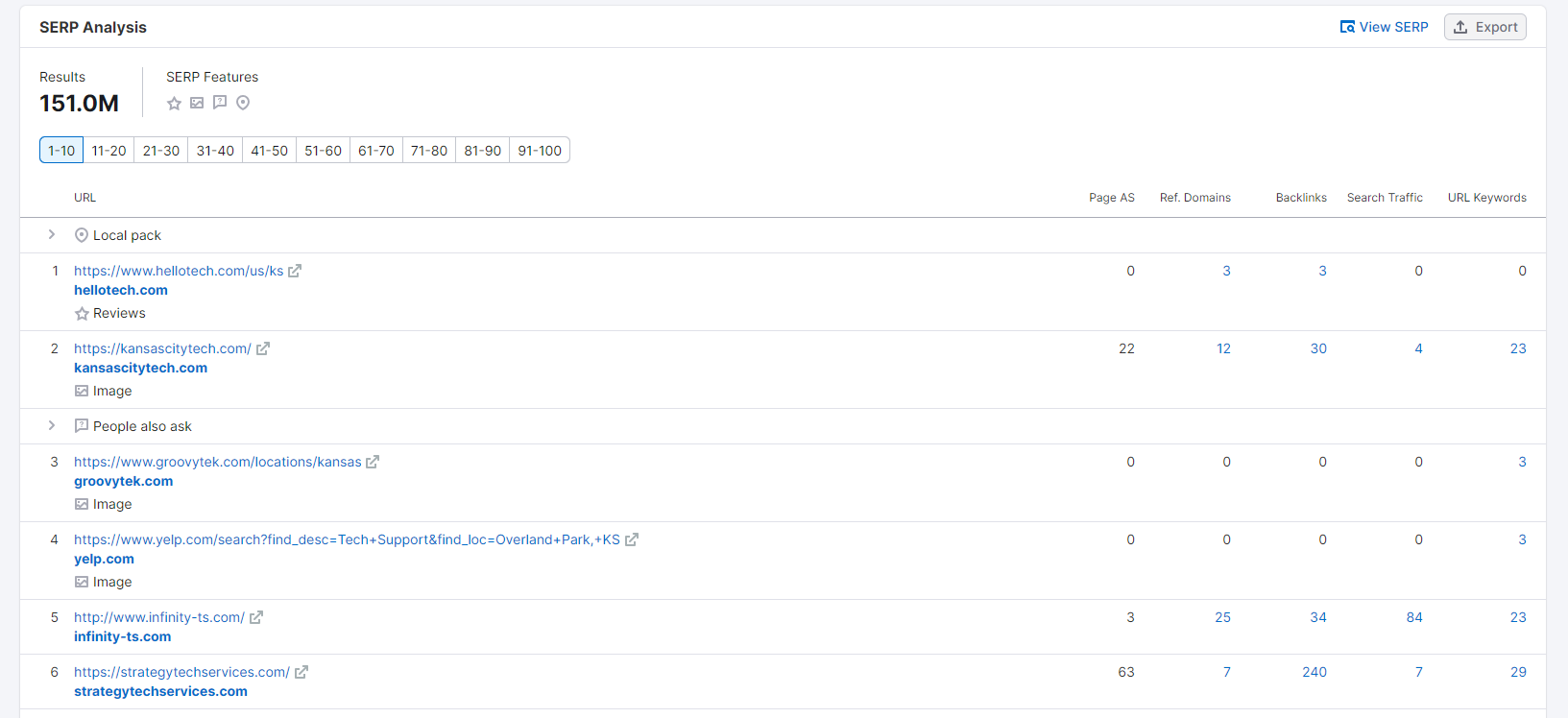
You need to know who your real competitors are. For example, here one of the organic results is Yelp.com, which is not exactly an IT company. So, don’t waste your time with domains that’re not even your competitors.
Here’s how to find niche-based competitors with Semrush:
Step 1: Go to SEMRUSH’ “Organic Research”

Step 2: Enter your domain

Step 3: Go to “Competitors”

Step 4: Get your results
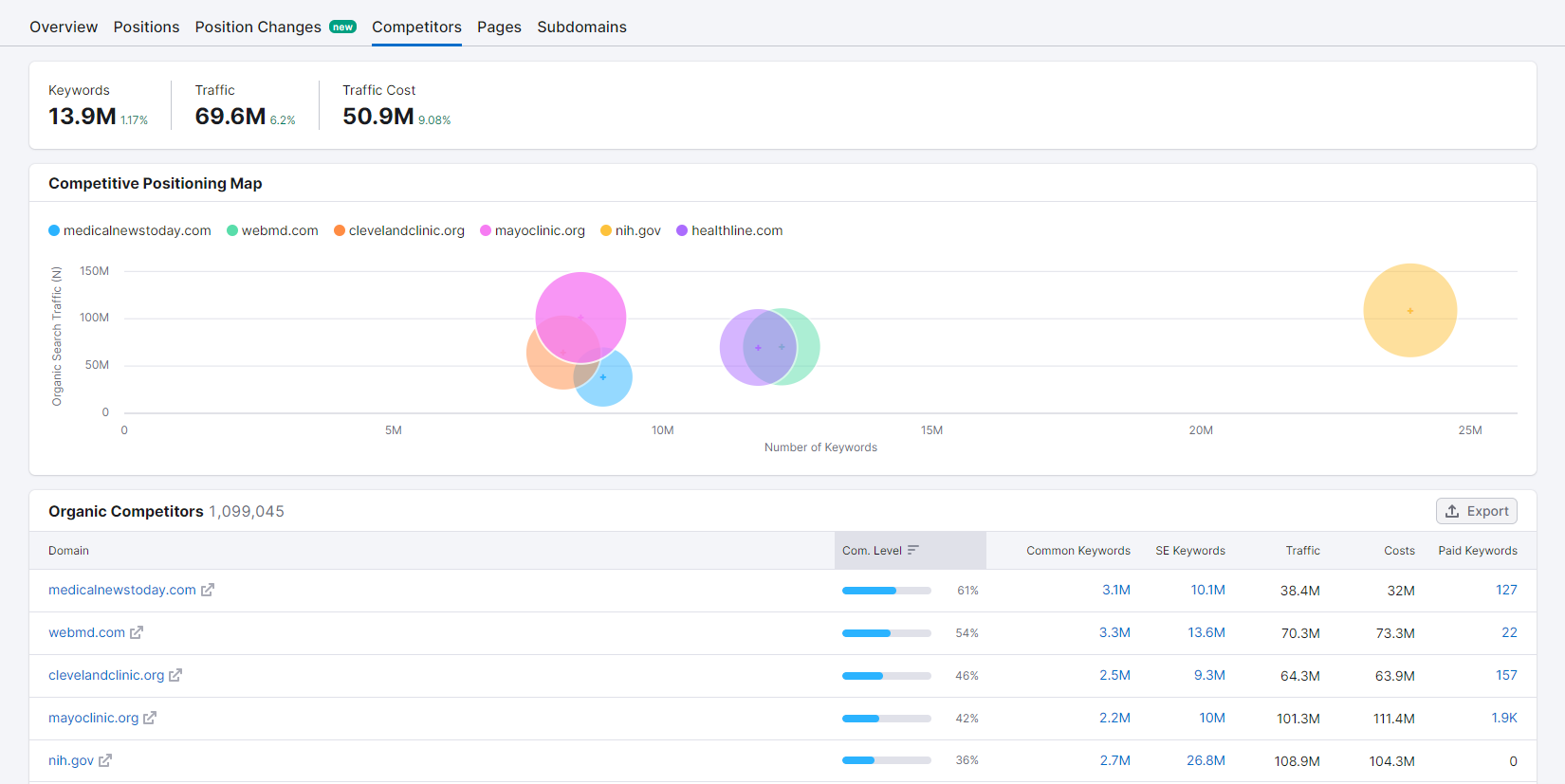
Let’s do a keyword gap analysis first. The purpose is to find keywords that your competitors are ranked for but you aren’t.
Go to “Keyword Gap” in SEMRush. Type in your domain in one of the boxes and your competitors in the rest. Click “Compare” and see the result for yourself.
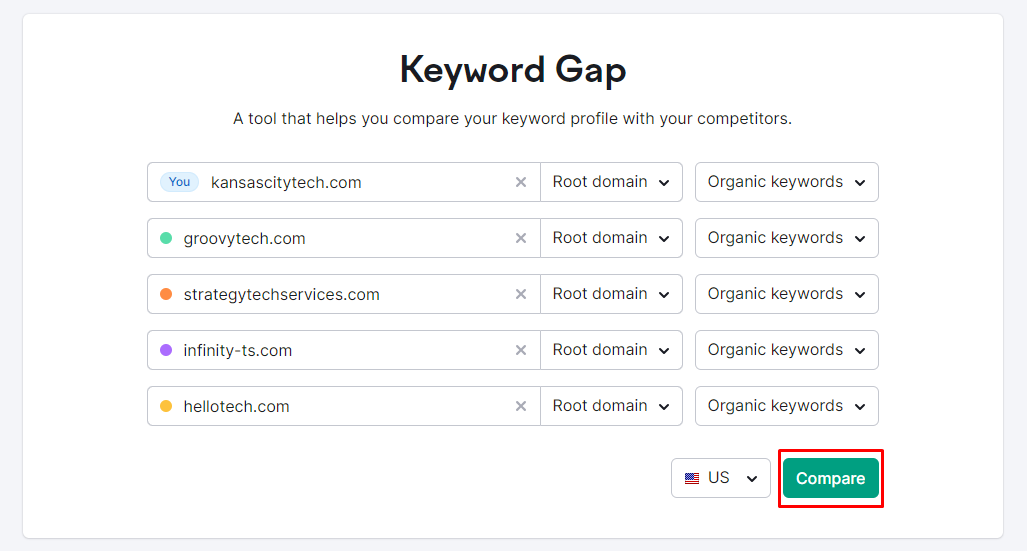
Let’s look at the keyword gap between Kansascitytech.com and their competitors.

If you select the “Untapped” filter, you’ll see a list of keywords that Kansascitytech.com never used but their competitors did. So, you can capitalize on those keywords and strategize accordingly for better rankings.
The goal is to use keywords with lesser keyword difficulties (KD) but more search volumes (SV). So, find your ideal keywords from the list and build your SEO from the ground up.
You should be aware whether your competitors are using new keywords or not. If they are, you should also use the same keywords.
Go to SEMRush’s “Organic Research” tool again. Type in your competitor domain and click “Search.”
We are going to take hellotech.com as our primary competitor and analyze their keywords.
The search result for the domain will return with all the keywords it has ever used. However, you have to go over to the “Position Changes” tab and choose the “New” filter to get the new keywords.
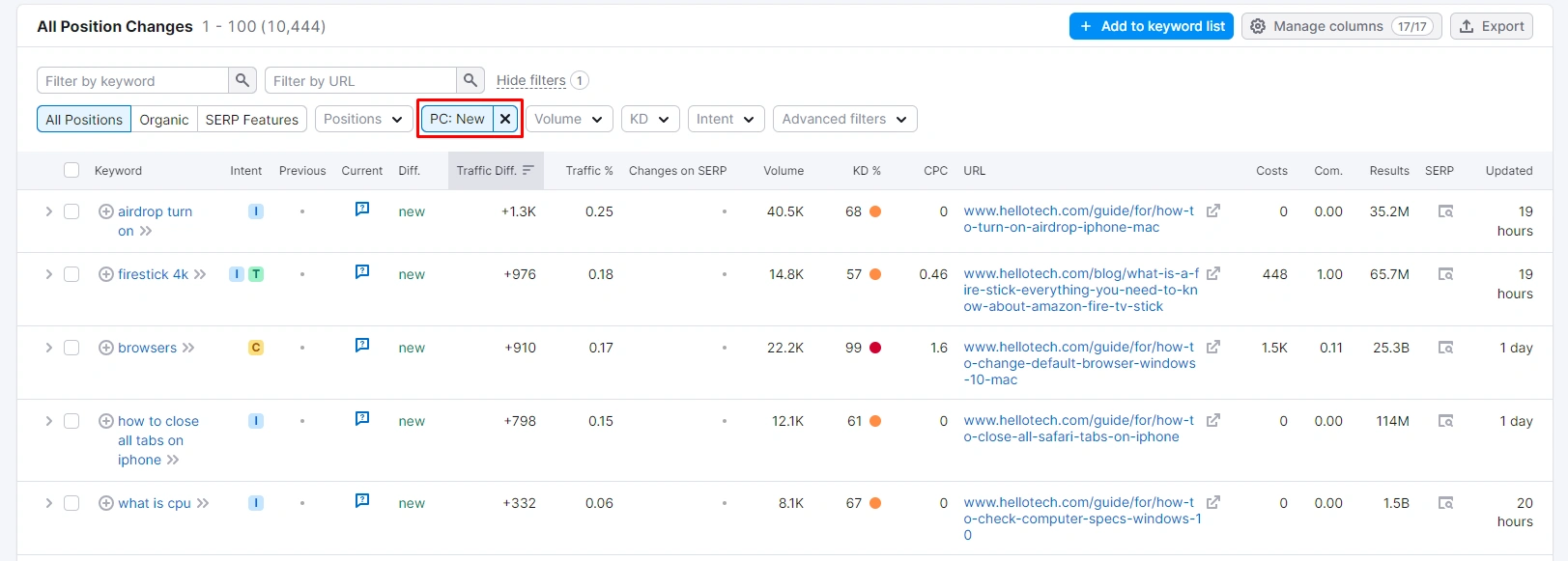
Individually analyze each keyword to stay ahead of the competition. You’ll find the page URL wherein a specific keyword is located. Navigate to the page and see how relevantly they used their keywords and what the content was all about.
Focus on the search volume and KD and pick the best keyword to work with.The right keyword not only depends on how you can use it to meet your business goals but how the global competitors are leveraging that keyword as well.
For instance, we can see in the last result that “airdrop turn on” is a popular keyword with lesser keyword difficulty. A simple google search with the keyword will give you an idea about how you can make the best out of it.

As you can see, the SERP shows mostly blog posts for this keyword. So, if you can create high-quality informative blogs on “airdrop turn on,” you’ll have a higher chance to make it to the top.
Again, it’s all about the user intent. You should analyze all such keywords and optimize your own strategy to cater to the right audience. You can use long-tail keywords to further narrow down to a specific audience and increase user engagement.
This is a simple trick you can use to take advantage of your competitor’s data.
Your competitors might have lost a lot of keywords in their journey so far. The reasons may be varied such as Google spam updates for which they had to remove a questionable page or content or they had stopped giving information about a specific topic.
Whatever may be the case, this serves as a golden opportunity for you to pick up the pieces and leverage them to your benefits.
Again, it’s very easy to find out the lost keywords of your competitors with SEMRush.
Go to “Organic Research” and type in your competitor’s root domain.
Now choose the “Lost” option from the “Position Change” dropdown tab.
This will show all the keywords that the site has lost over time.
Let’s go after the lost keywords of hellotech.com:
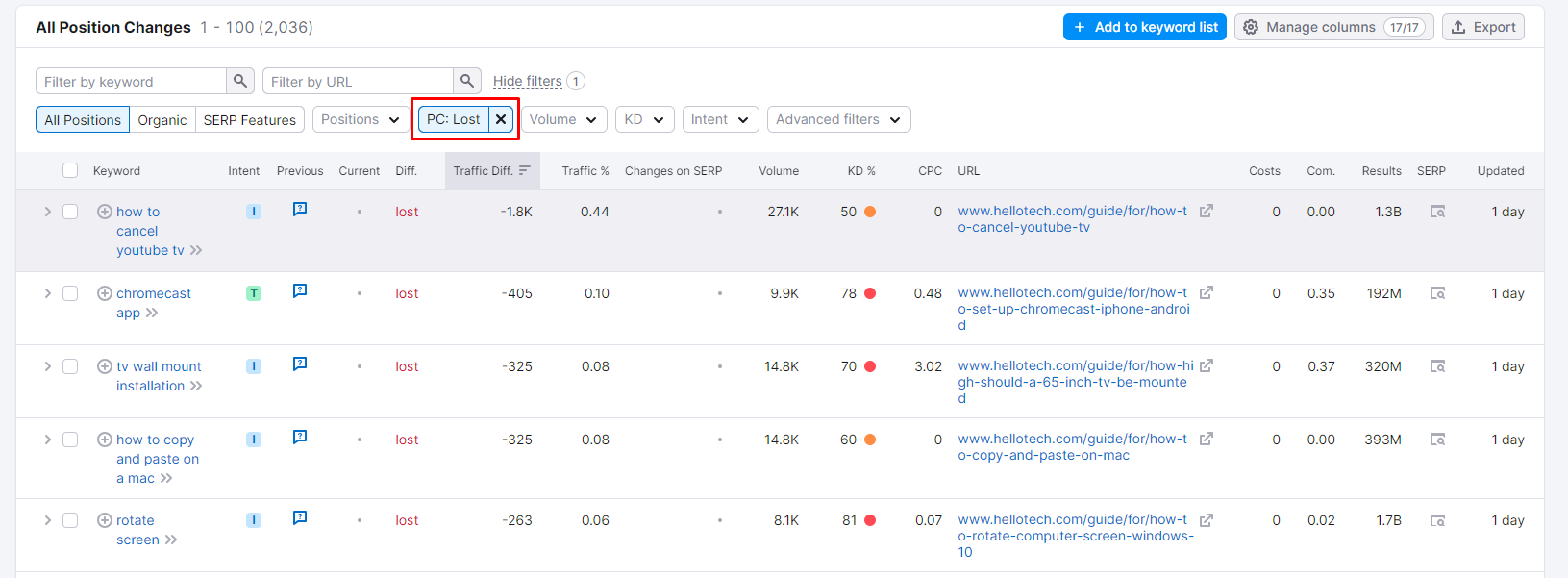
The keyword “how to cancel youtube tv” seems like an obvious choice for its good search volume and a reasonable KD score.
Keep the essentials in mind: you need to target keywords with lesser difficulty in SERP competition and those that users search for more. The rest is up to you in terms of how you want to analyze the keywords with an SEO tool.
Your competitor content analysis has to be mostly manual. Tools are not equipped to tell you a whole story about the content.
You have to observe each of your competitor’s content and note down what has made them exceptional and in some cases, what went wrong.
Read between the lines and try to crack their content strategy.
Do they publish a specific type of content throughout? Do they diversify their content very often? Are they more focused on product pages or blogs and guides? Can you call them “quality content” after all?
You should also think about: what type of content is working for them and what isn’t?
Imagine your competitors are putting out blogs and gaining regular traction. You can then start optimizing your own blogs to be more SEO-friendly.
There is an easier way to do that if you are an opportunist. If a competitor’s content is failing for some reason, you can take advantage of this situation.
For example, if the competitor is not regularly updating their blogs, you can start being more active with new blogs and fill up the information gaps for the niche audience.
You can also make use of the “Skyscraper” technique. This is where you need to give more effort to create more efficient content than your competitors’ basic ones and grab more attention.
If you have a keyword in mind but don’t know if you should proceed with it for your new content, you can use SEMRush’s “SEO Content Template” to analyze the competitors’ content for a specific keyword and get tons of other suggestions for your content.
Go to “SEO Content Template” and type in a keyword of your choice. Suppose you want to write about “the best video doorbells.” Type it in and click ‘Create Content Template.’

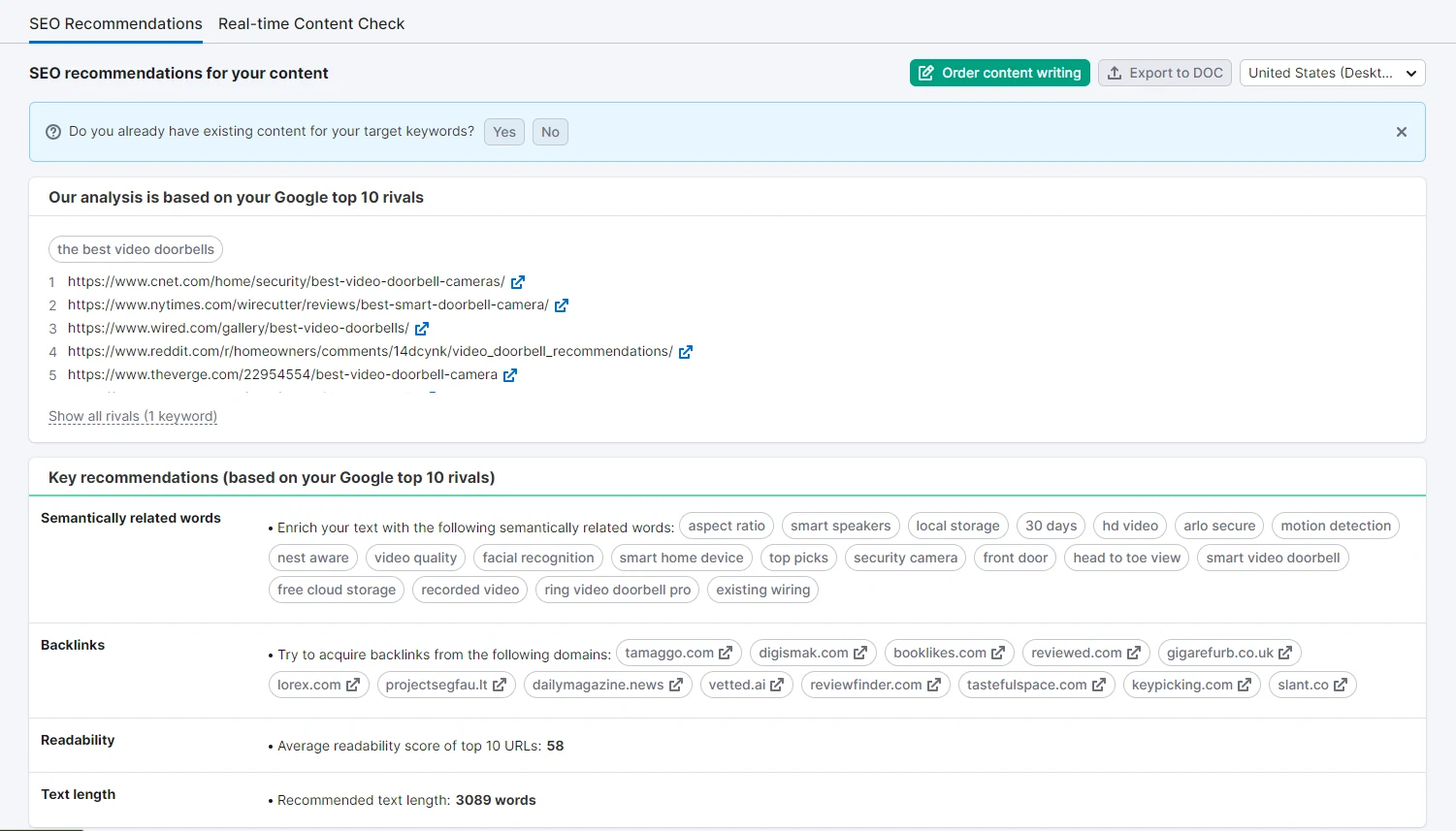
The result shows the top 10 competitors for this keyword and based on them, provides you with SEO recommendations like semantically-related keywords that you can incorporate in your content to enrich your text, referring domains you can get your backlinks from, and even the number of words that your content should have.
You’re learning here how to do competitor analysis in SEO. So, don’t leave any stone unturned.
Not all analysis requires a specialized SEO tool. If you have some idea about SEO, you can find your own way.
For example, titles and meta descriptions are an important part of SEO but there’s no specific metric to decide how these texts are helping your competitors with their rankings. You need to apply logic to find the pattern that works best.
Let’s take our earlier example of the keyword “airdrop turn on” and search it up on Google.

The top competitors are showing varied types of title tags. You have to consider a couple of things here:
After a thorough analysis like this, you can now create your title tags to rank better.
The same goes for meta-descriptions as well although they are often overlooked since they’re not a direct ranking factor. However, if the description can summarize a content effectively, it can still help drive traffic to your site.
See how your competitors have written their meta-descriptions and make yours better to entice the audience into clicking on your link.
First paste a competitor’s root domain in SEMRush’s ‘Backlink Analytics’ tool.
We’re working with “hellotech.com” again for this analysis.
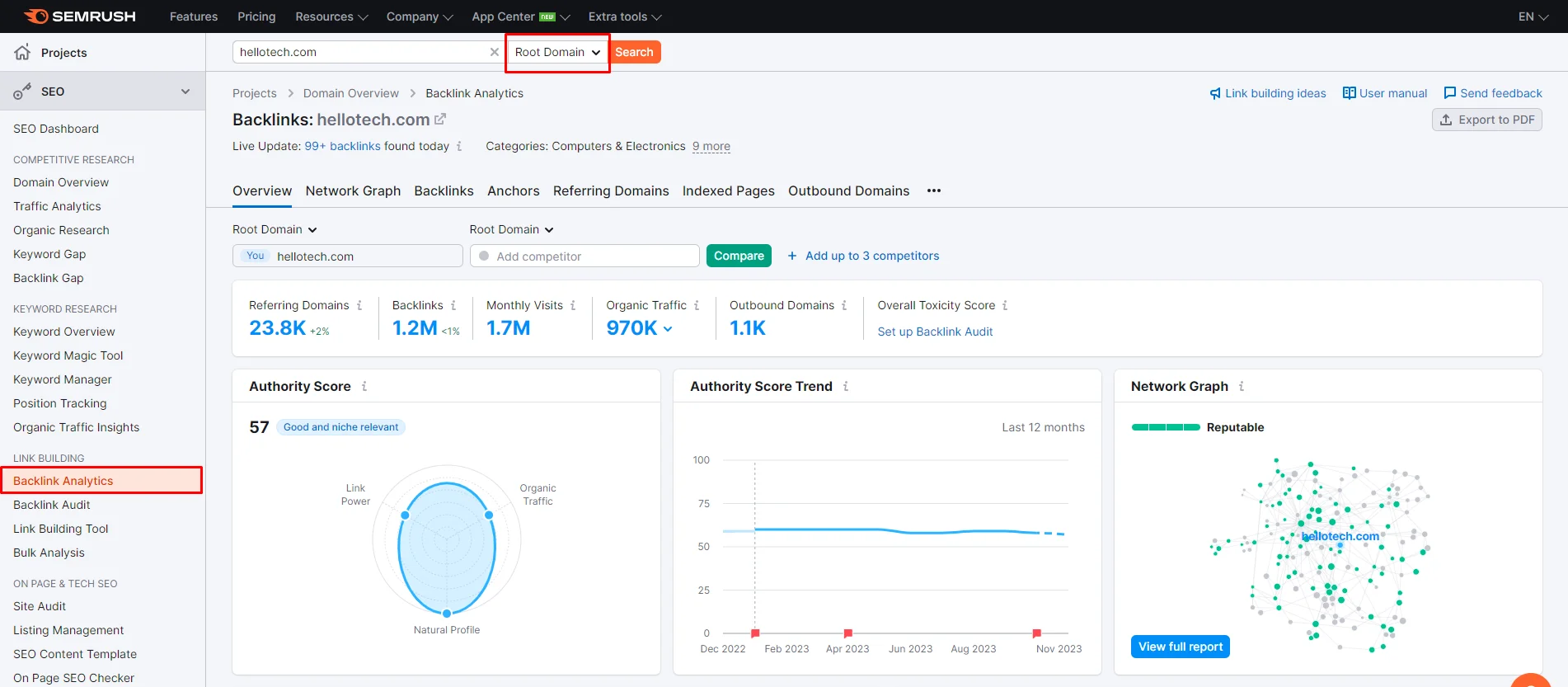
The very first page you see is the overview. This one is only here for a quick look at the backlink profile of your competitor. You’ll find out the number of backlinks and referring domains, the domain authority score and other graphical data to get you started on the analysis.
Switch to the ‘Backlinks’ tab on the same window and see the complete list of backlinks your competitor has.

You can now analyze every single backlink from this interface by manually scrolling through and understanding their placement. Find the referral domains or websites they came from and see how many of them were authoritative. You can also examine the anchor texts that your competitor used and how they were written.
This has been made easier with different filters you can use now to satisfy your search intent.
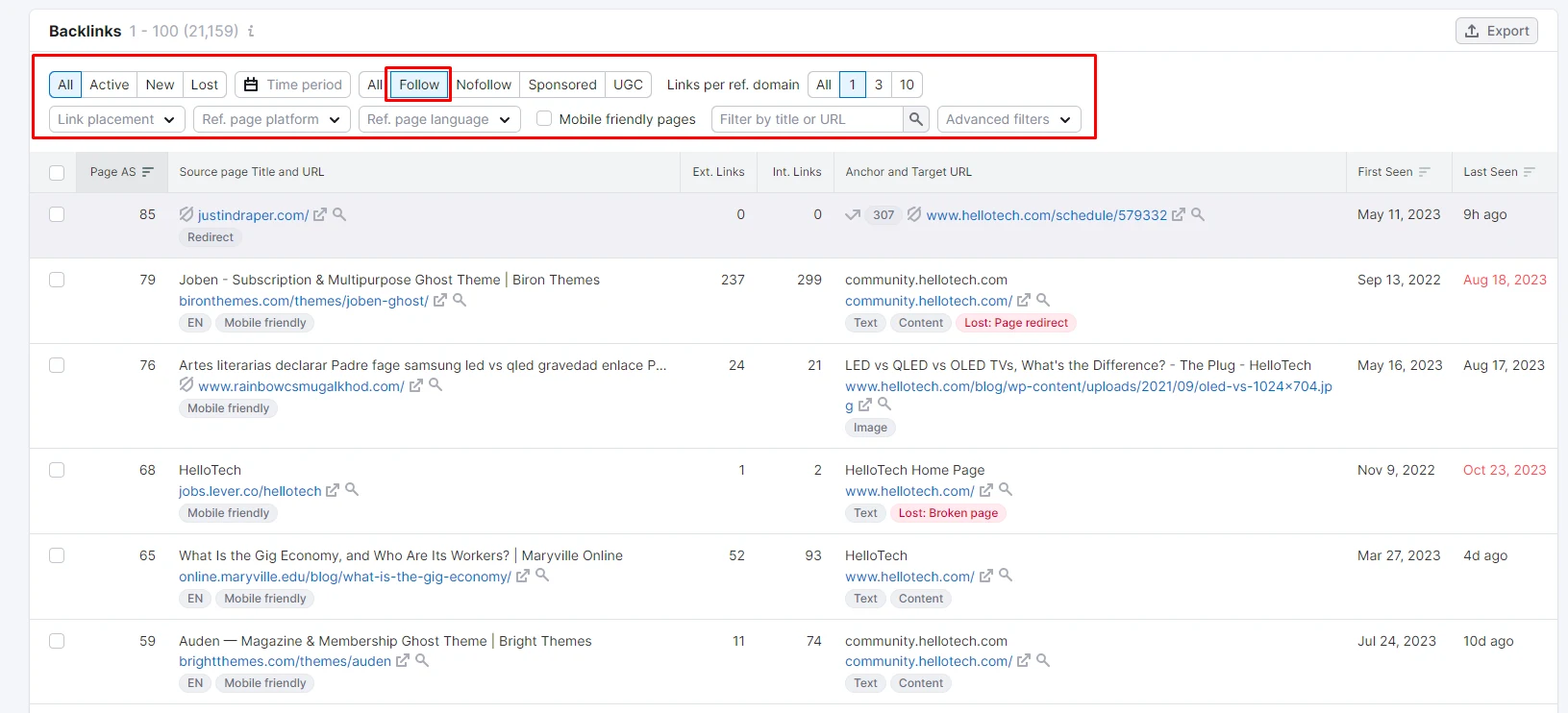
For example, you can decide whether you want to analyze the dofollowed or nofollowed backlinks only.
Your competitors might have lost a lot of backlinks for one reason or another. If you want to sweep them away for broken link building, choose the Lost filter and make your mark.
This type of analysis gives you a list of referring domains that have provided backlinks to your rivals but not you.
This is useful in competitor research since it opens up new opportunities for you to chase backlinks. Since those websites have linked to your competitors, there’s a high probability that they’ll link to you as well if you can convince them with your content and authority.
Go to ‘Backlinks Gap’ in SEMRush and paste your root domain alongside those of your competitors.
We’re going to input Kansascitytech.com in the “You” tab and the rest from our list as its competitors.
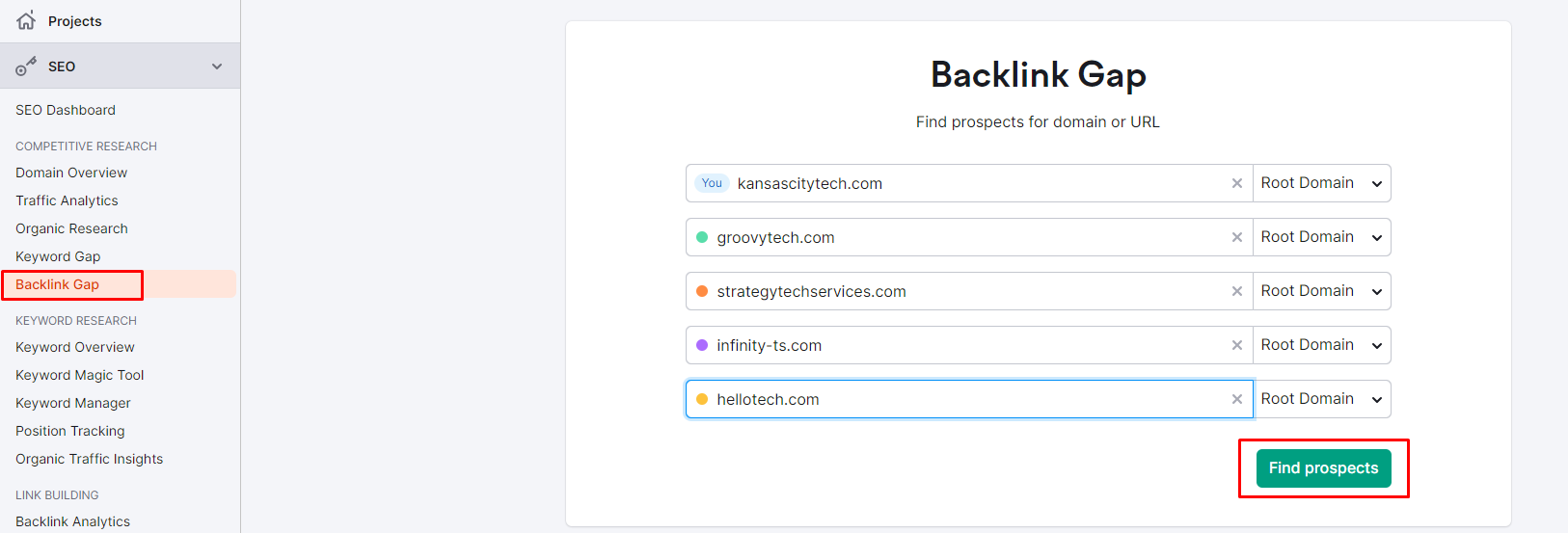
Click ‘Find Prospects’ and look out for your backlink gaps!
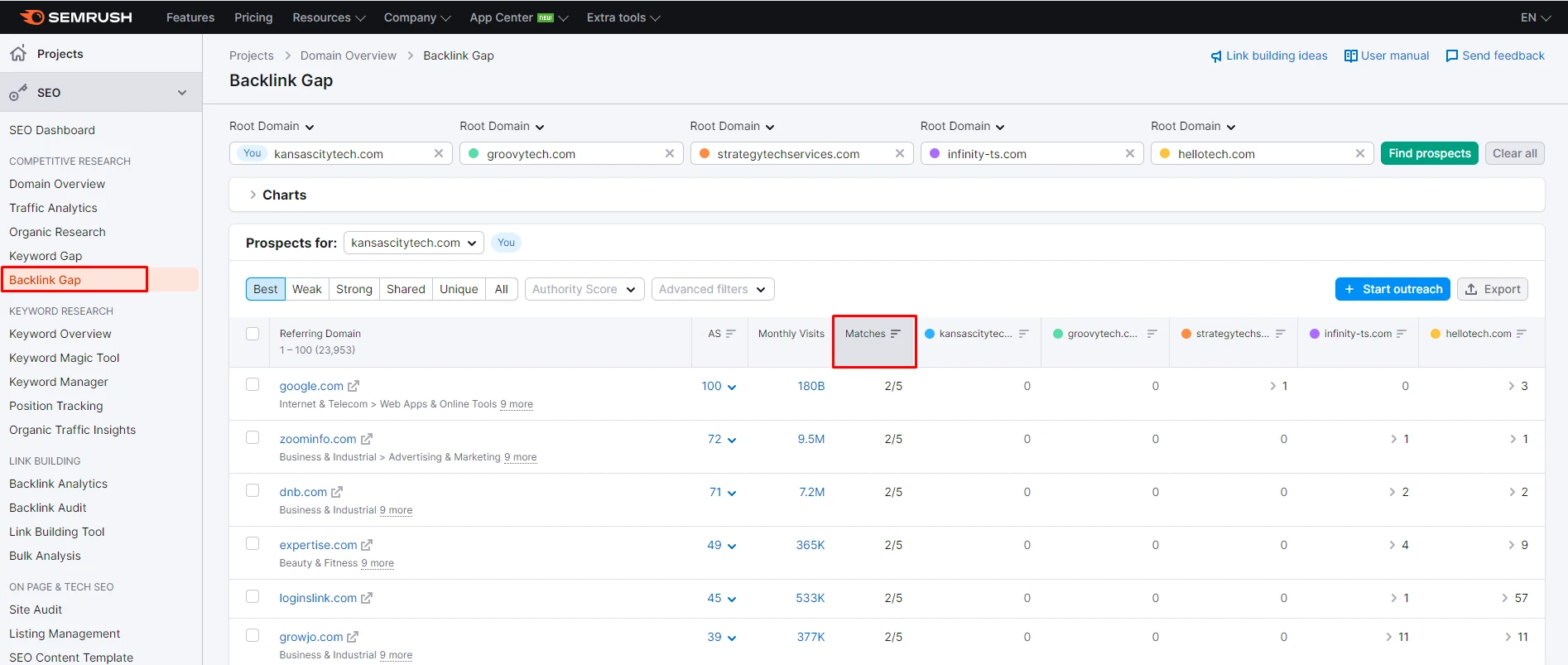
The referring domains in this page are ones that provided backlinks to the competitors but not to Kansascitytech.com. The ‘Matches’ column shows how many of the top competitors have received links from a particular website.
Now, you can analyze individual domains and see if it makes sense for you to go ahead and ask for a link from those sites as well.
If you’re smart enough, you should be able to figure out the pattern of websites that have provided inbound links to your niche. This will help you pick the right prospects for backlinks and of course, your business.
High-quality backlinks usually translate to higher authority. You can measure the authority of a site by their backlink profiles using the “Bulk Analysis” feature on SEMRush.
Just go to the tool and paste your competitor domains. Click “Compare” to get results.
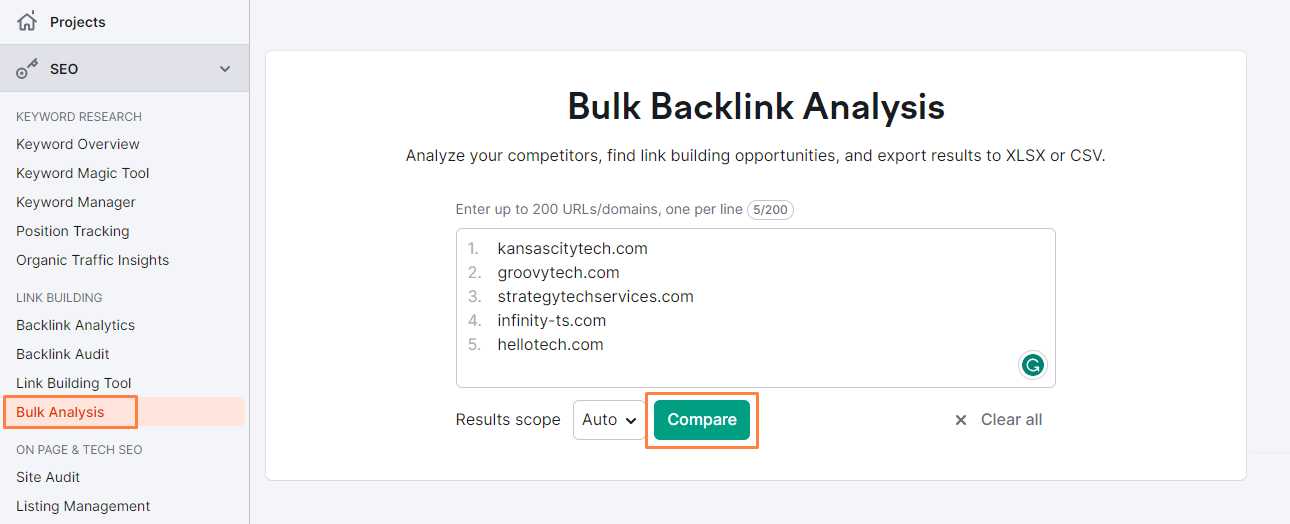
The higher your competitors’ AS (authority score- a metric developed by SEMRush scoring 0 to 100 based on backlink profiles of a site), the more difficult it’ll be to outrank them in the SERPs.
In this example, hellotech.com seems to be the most difficult competitor in your niche because of their higher AS and a robust backlink profile.
To increase your AS, manage your link building strategies better and get quality backlinks from authoritative and relevant websites.
Technical SEO means optimizing your website for improved user experience. Fortunately, you can directly measure how your site and your competitors are doing on their technical front with SEMRush’s ‘Site Audit’ tool.
Create a project in site audit and run the audit on the sites- both yours and your competitors’ so you can compare.
We are going to audit the competitor domain hellotech.com. Let’s see how it does in site audit.
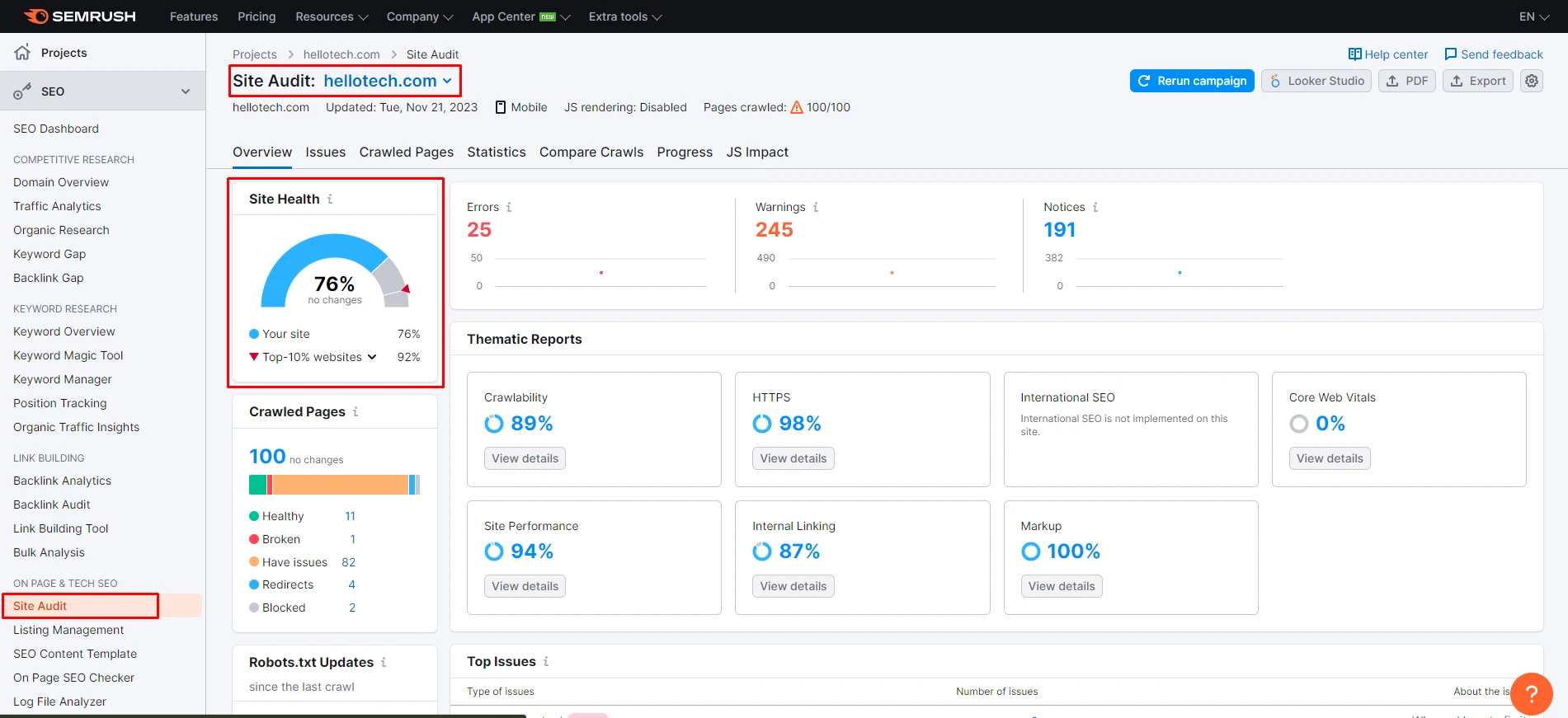
The “Overview’ page represents the overall technical SEO elements of the site. The ‘Site Health’ metric is the one that summarizes everything.
This SEMRush score ranges from 0 to 100 and reflects the total number of technical issues in that site. The higher the score, the fewer the issues.
Comparing the scores between your site and those of your competitors will give you an idea on how you should improve your site performance.
To determine the specific areas to work on, you have to navigate to the ‘Issues’ tab and find out.
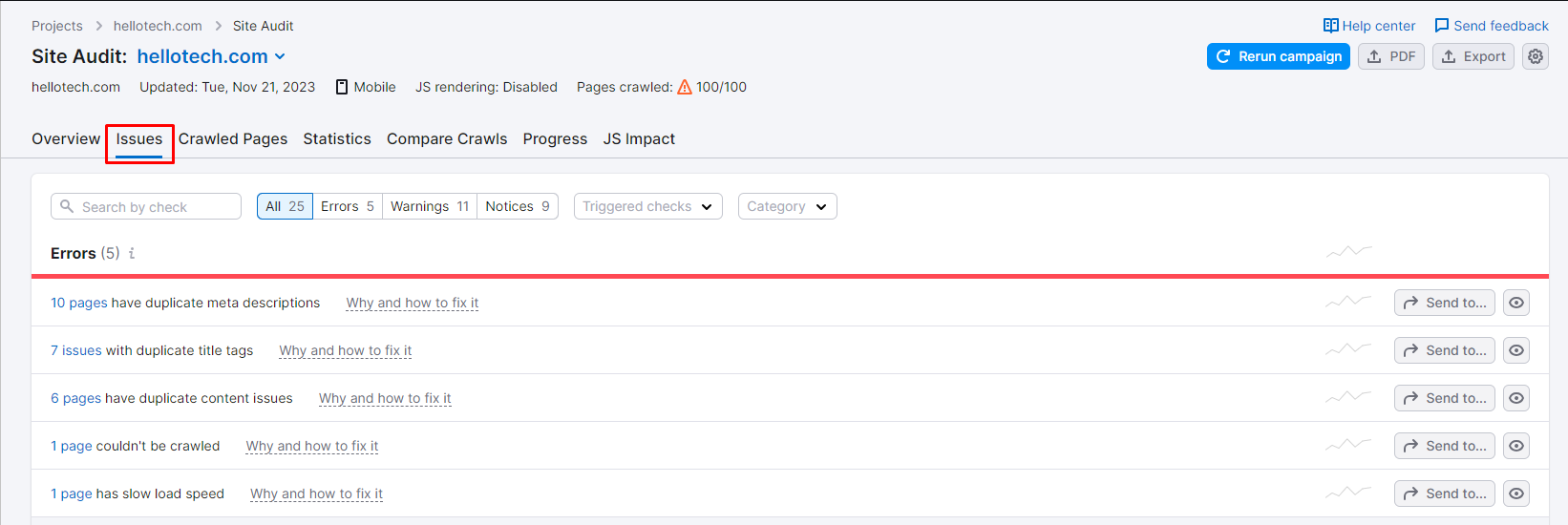
The “Issues” page lists all the technical errors of the site e.g. slow speed, duplicate content, broken links and so on. You have to take them all into account and try to fix them.
SEMRush offers some recommendations for each issue. You can follow them on your own or consult with an SEO expert to remove those red flags from your site (if any).
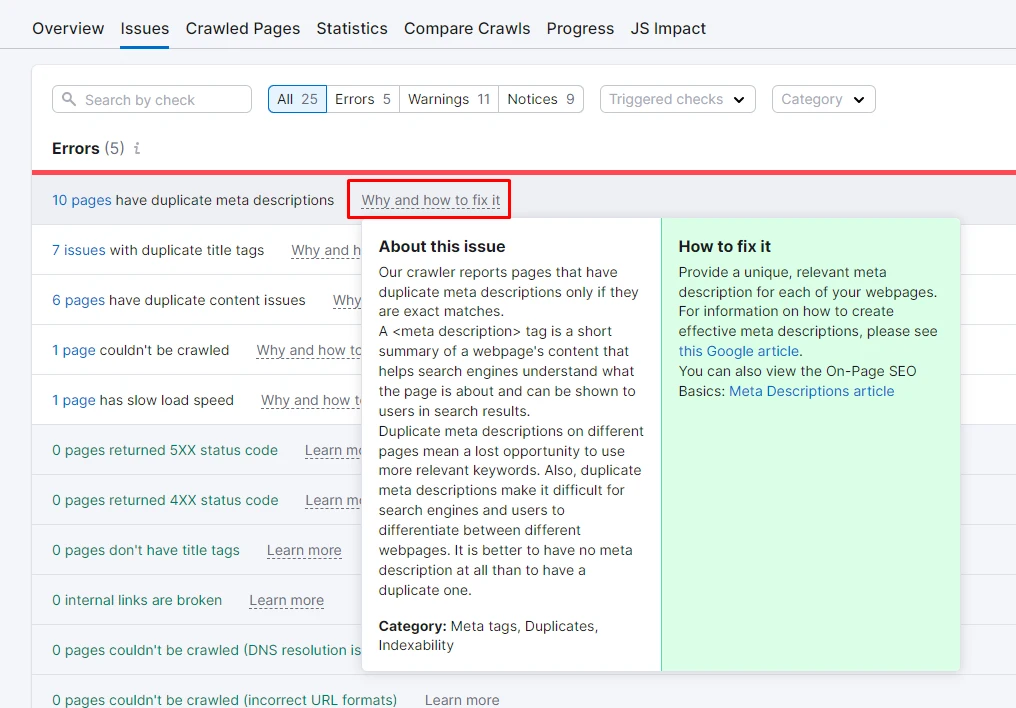
Your audit will reveal the errors that your competitors may have made. You can stand clear of them yourself and try to maximize your site performance from there on.
You need to be aware of other technical aspects that the audit may not cover. They might be some simple stuff that you can check out for yourself.
For example, let’s look at how Hellotech.com has done its topical clustering.

They provide different services as they’ve categorized here. Now, if you want to avail only computer support, you can pick from the homepage and navigate directly to their computer services.
You can follow a similar model for your own website and cluster your services like this to make it easy for users.
Once you know how to do competitor analysis in SEO, all there’s left to do is optimize your own SEO strategy.
Of course, you can’t just copy-paste your competitors’ strategy onto yours because every website goes through a subjective experience in their niche when they’re trying to outrank each other.
You have to readjust your tactics learning from your top competitors but with the mindset of satisfying the user intent.
Some specific measures you can take are-
Website competitor analysis is important for a number of reasons.
SEO performance is never constant for a site. With the evolving Google algorithms and fluid search engine ranking, you have to adapt and reinvent your strategies.
Many think SEO competitor analysis is a one-time activity but that’s far from the truth. There are many instances you might have to research your competitors for a clue on how to take your next step. For example,
Don’t throw away your investment of time and efforts into competitive analysis by making some very common errors-
If you are a fresh face in digital marketing with no idea how to get all of this done effectively or too engaged to give special attention to time-to-time competitive analysis, you can rely on LinkBuilderPros.
We have been a full-fledged SEO agency for 10 years now. Our services are well-received globally due to our professionalism and result-driven approach, proven track records on a number of services, and higher efficiency in all departments.
Get in touch with us with your demands for your competitive analysis, we’ll be there for you with a custom solution in hand.
Competition is a huge part of the grind in SEO marketing.
If you’re down in the field, expect some cut-throat competitors – all looking to outrank you!
If you think about it, you’re just the same to them. So, there’s no way to avoid it.
What you can do is learn how to do competitor analysis in SEO and cut your way through the SERP.
Our blog here has outlined everything there is to know about how to do competitor analysis in a step-by-step format. We also talked about when you should conduct an analysis, what you should be looking for in each and what stuff to avoid while coming to a conclusion.
Note them all down and get to work! Good luck.
Q. Can I Conduct Competitor Analysis Manually?
Ans. You sure can. However, using specific SEO tools only streamlines the process, saves the time and helps you score accuracy with the analysis.
Q. Is Local SEO Considered in Competitor Analysis?
Ans. Absolutely. You should look at location-based keywords and analyze Google business profiles for your local competitors.
Q. What Role Does Social Media Play in Competitor Analysis?
Ans. Social media analysis reveals the user engagement of your competitors. Find out the content pattern on their social media pages and take a note of how they interact with the users.
Q. Can I Use Competitor Analysis for Paid Advertising Strategies?
Ans. Yes, you can assess your competitor’s paid strategies such as advertising campaigns and try to make sense of how you can run one as well.